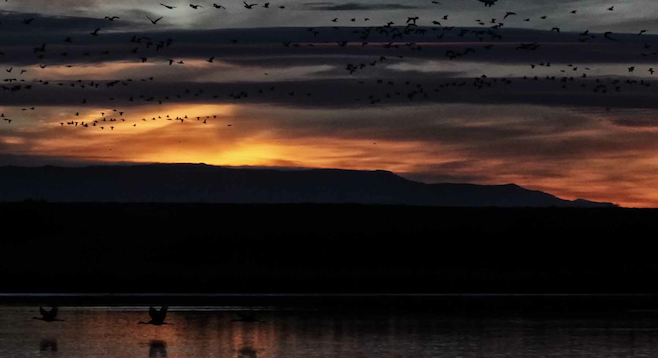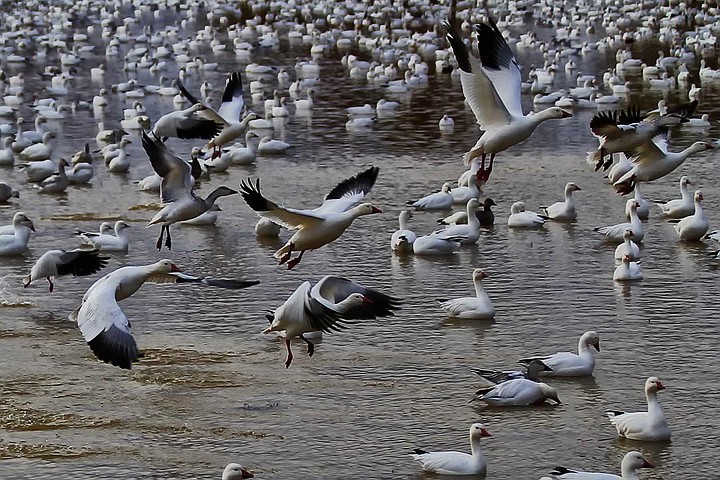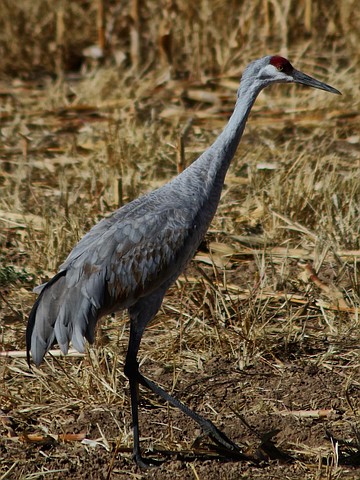 Facebook
Facebook
 X
X
 Instagram
Instagram
 TikTok
TikTok
 Youtube
Youtube

It’s 5:30 a.m., 27 degrees and pitch-black dark on a November morning in New Mexico. I’m standing in a small group on a wooden platform built out over the water named “The Flight Deck.”
Although we can’t see a thing, we hear random calls of ducks and geese somewhere out in the wetlands that stretch beyond the platform. As the dawn begin to turn the sky pink and then red above the San Pascual Mountains in the eastern horizon, there is a rising of quacking, clucking and whistling and we begin to see shapes of birds sitting and standing in shallow water all around.
Then, all at once, it happens. Literally thousands of calling geese, cranes and ducks fill the crisp morning air and rise together into the morning dawn. They break off into smaller groups, heading out in different directions towards nearby fields and ponds for the day’s grazing.

In a matter of minutes, these thousands of geese and cranes and ducks are gone. We’re told they will all return before sunset to spend the night together in this water where they’re safe from nighttime predators.
This daily cycle is the “fly in, fly out” performance at Bosque Del Apache National Wildlife Refuge. It’s a fall rite of passage here, and will continue until spring when the birds all head north.
For millennia, thousands of geese, cranes, ducks and a variety of other migratory birds have descended to this small stretch of the Rio Grande in southern New Mexico. They come from as far away as Alaska, Montana and Wyoming. The refuge consists of 57,331 acres along the Rio Grande at the northern edge of the Chihauhuan desert about 20 miles south of Socorro, New Mexico.
And for the last 25 years, a large flock of homo sapiens have also migrated here for a week to witness this wonder. It’s called “The Festival Of The Cranes.”
The festival includes guided tours of the refuge and surrounding desert, mountains and lakes, lectures and workshops, art and equipment displays. There are hiking trails and driving loops through the area with food and lodging 20 minutes away. A lot of bird watchers show up, but the crowd consists of really just anyone who loves nature.

The celebrities of the festival are the approximately 6,500 Sandhill Cranes who fly in from summer homes in the arctic. These grayish birds are a bit larger than the Great Blue Herons we see around San Diego with a red patch on their head. Their long wingspan lets them glide like 787s on approach for a landing, and all day small groups can be seen and heard calling.
Along with the cranes are about 40,000 very beautiful (and noisy) white snow geese along with about another 15 species of ducks, a myriad of hawks, woodpeckers and small migratory birds.
A "bosque" is woodland area surrounding the floodplain of a river and consists of marsh, flooded field and streams, which make a perfect habitat for wildlife. Food for the flocks of birds come from local farms, as commercial farming is allowed within the Refuge as long as a sufficient portion of the crop is left for the wildlife to graze on.
In addition to the birds there are coyote, wild turkey, white tailed and mule deer, wild javelina pigs, raccoon, mountain lion, and pronghorn antelope on the prairie not far away.
It’s a wildlife safari Southwest-style, and only a few hours’ flying or a day's driving away.


It’s 5:30 a.m., 27 degrees and pitch-black dark on a November morning in New Mexico. I’m standing in a small group on a wooden platform built out over the water named “The Flight Deck.”
Although we can’t see a thing, we hear random calls of ducks and geese somewhere out in the wetlands that stretch beyond the platform. As the dawn begin to turn the sky pink and then red above the San Pascual Mountains in the eastern horizon, there is a rising of quacking, clucking and whistling and we begin to see shapes of birds sitting and standing in shallow water all around.
Then, all at once, it happens. Literally thousands of calling geese, cranes and ducks fill the crisp morning air and rise together into the morning dawn. They break off into smaller groups, heading out in different directions towards nearby fields and ponds for the day’s grazing.

In a matter of minutes, these thousands of geese and cranes and ducks are gone. We’re told they will all return before sunset to spend the night together in this water where they’re safe from nighttime predators.
This daily cycle is the “fly in, fly out” performance at Bosque Del Apache National Wildlife Refuge. It’s a fall rite of passage here, and will continue until spring when the birds all head north.
For millennia, thousands of geese, cranes, ducks and a variety of other migratory birds have descended to this small stretch of the Rio Grande in southern New Mexico. They come from as far away as Alaska, Montana and Wyoming. The refuge consists of 57,331 acres along the Rio Grande at the northern edge of the Chihauhuan desert about 20 miles south of Socorro, New Mexico.
And for the last 25 years, a large flock of homo sapiens have also migrated here for a week to witness this wonder. It’s called “The Festival Of The Cranes.”
The festival includes guided tours of the refuge and surrounding desert, mountains and lakes, lectures and workshops, art and equipment displays. There are hiking trails and driving loops through the area with food and lodging 20 minutes away. A lot of bird watchers show up, but the crowd consists of really just anyone who loves nature.

The celebrities of the festival are the approximately 6,500 Sandhill Cranes who fly in from summer homes in the arctic. These grayish birds are a bit larger than the Great Blue Herons we see around San Diego with a red patch on their head. Their long wingspan lets them glide like 787s on approach for a landing, and all day small groups can be seen and heard calling.
Along with the cranes are about 40,000 very beautiful (and noisy) white snow geese along with about another 15 species of ducks, a myriad of hawks, woodpeckers and small migratory birds.
A "bosque" is woodland area surrounding the floodplain of a river and consists of marsh, flooded field and streams, which make a perfect habitat for wildlife. Food for the flocks of birds come from local farms, as commercial farming is allowed within the Refuge as long as a sufficient portion of the crop is left for the wildlife to graze on.
In addition to the birds there are coyote, wild turkey, white tailed and mule deer, wild javelina pigs, raccoon, mountain lion, and pronghorn antelope on the prairie not far away.
It’s a wildlife safari Southwest-style, and only a few hours’ flying or a day's driving away.
Comments